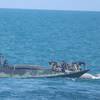The U.S. Navy is confident that it will successfully raise the Japanese fishing vessel sunk off Hawaii in February by one of its nuclear submarines, and was hopeful of recovering some of the bodies of the nine people killed in the accident. As final preparations were being made on board a salvage vessel for next week's attempt, Rear Adm. William Klemm, the officer in charge of the $40 million operation to recover the Ehime Maru, rated the Navy's chances of successfully raising the ship as high as 80 percent.
"I have very high confidence that we will be able to get to the point where we can lift the ship," Klemm said. "I think the much greater risk comes at the point where we raise the ship and have to move it."
"If we have broken the ship so severely, it will prevent us from continuing the mission," he added.
The Navy has hired a civilian ship, Rockwater 2, from a Texas company to gently raise the 190-ft. (58-m) Ehime Maru off the ocean floor 2,000 ft. (610 m) below the surface, carry it in a giant sling 13 nautical miles and set it down in shallow 115-ft. (35-m) waters where divers can enter and search for bodies.
The Ehime Maru, a trawler used to teach Japanese high school students about the fisheries industry, was about 9 miles (14 km) off Oahu, Hawaii on Feb. 9 when it was rammed by the USS Greeneville during an emergency surfacing drill and sank.
Twenty-six people survived but nine people, including four teen-age boys, were never found. The Navy promised their relatives that every attempt would be made to recover their bodies, but Klemm said he expected divers to only find five to seven of the missing people.
Based on their last-known locations on the ship, Klemm said some of those killed may have made it to the outside of the sinking ship but died when it slipped beneath the waves.
The Rockwater 2 is expected to head out to sea early next week and Klemm said the Ehime Maru will probably be moved in late August and that divers would attempt to recover bodies in September.
More than 45 divers will work from a barge anchored over the ship in shallow waters, and they expect to have to force their way through mangled passageways and watertight doors.
Stuart Ramage, master of the 5,991-ton Rockwater 2, said his ship had special thrusters to keep it stationary during the recovery operation in which remote submersibles will attach 4-in. (10-cm) thick cables to the Ehime Maru. "We've picked up aircraft and helicopters, but we have never picked up anything like this," Ramage said of the 499-ton ship. "We all appreciate the sensitivity of this and hope we can do a successful job." - (Reuters)
Featured videos

Inmarsat Enhances Service to Drive Digitalization

Unlock Onboard Data Efficiencies

Tracking Foreign Vessels Working in the U.S. Jones Act Market
Subscribe for
Maritime Reporter E-News
Maritime Reporter E-News is the maritime industry's largest circulation and most authoritative ENews Service, delivered to your Email five times per week









